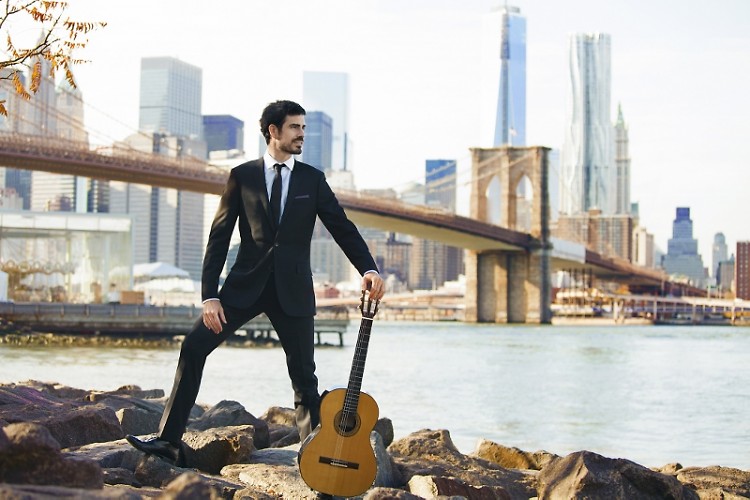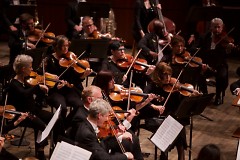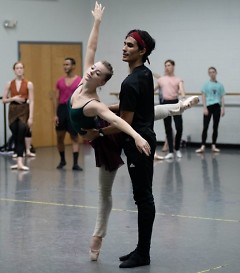Astor Piazzolla, who is to the tango what John Philip Sousa is to the march, grew up in Argentina, playing tangos on the bandoneon, an instrument related to the accordion.
Determined to become a serious composer of classical music, Piazzolla spent a decade writing symphonies, piano concertos and chamber music. After winning a composers’ competition, he was given the opportunity to study with the famed French pedagogue Nadia Boulanger, mentor to composers such as Aaron Copland and Philip Glass.
When Piazzolla presented his work for the first time to Boulanger, she stopped him in his tracks.
“All of a sudden she says, ‘Why don't you play a piece of the music you write in tango? I'm very much interested,’” Piazzolla recalled in an interview with the Washington Post in 1988.
“I played eight bars, and she just took my two hands and put them against her chest and said, ‘This is Astor Piazzolla. This is the music you have to go on writing, not that. Throw that into the garbage.’”
“And that's what I did,” Piazzolla continued. “I threw 10 years out of my life into the garbage. Now I write classical music, or symphonies, but always with a tango taste in it, trying the most to be Astor Piazzolla always.”
Grand Rapids Symphony, joined by dancers from Grand Rapids Ballet, will perform Two Tangos by Piazzolla on Friday and Saturday in DeVos Performance Hall for a concert titled “Rhythm of the Dance.”
The concert of spicy Spanish and lush Latinx music from both sides of the Atlantic Ocean also welcomes Spanish guitarist Pablo Sáinz Villegas back to Grand Rapids to play the world’s most popular concerto for guitar and orchestra, Joaquin Rodrigo’s Concierto de Aranjuez.
Music Director Marcelo Lehninger leads the Grand Rapids Symphony in music by Spanish composer Manuel de Falla Suite No. 1 from The Three-Cornered Hat, and Three Latin American Dances, a contemporary work written by Gabriela Lena Frank, a Grammy Award-winning American composer of Peruvian descent.
The Brazilian-born conductor also will lead the orchestra in Argentinian composer Alberto Ginastera’s Four Dances from Estancia.
“It’s such a fun piece,” Lehninger said. The last movement makes you want to jump out of your seat.”
If there’s one musical instrument that defines Spanish music, it’s the guitar, and if there’s one piece for guitar and orchestra that towers above all others, Rodrigo’s Concierto de Aranjuez, a piece inspired by the gardens at the Royal Palace of Aranjuez in Spain.
Villegas, a past winner of the Andres Segovia Award as well as the first winner of the Christopher Parkening Guitar Competition, returns to DeVos Hall, two years after his Grand Rapids Symphony debut in January 2016.
“He is an incredible Spanish guitarist,” said Lehninger, who worked with Villegas last year in North Carolina.
Having lost his sight at the age of 3, Rodrigo was a virtuoso pianist and gifted composer. Though he was not a guitar player himself, several of his works for guitar and orchestra are among the most beloved in the repertoire.
Composed in 1939 and premiered the following year, Concierto de Aranjuez includes one of the most hauntingly beautiful English horn solos in the symphonic repertoire. It was inspired by the gardens at the Palacio Real de Aranjuez, the spring resort built by King Philip II in the latter half of the 16th century in the town of Aranjuez, 30 miles south of Madrid. The music transports audiences to another time and place.
“For me, the guitar is the most wonderful and expressive instrument,” Villegas told Billboard Magazine in 2016. “When I play a concert, people always say, ‘I never heard the guitar sound the way that you play it.’ And that is exactly what I am looking for. We’re talking about an emotional connection through the music using the guitar.”
Born and raised in La Rioja, Spain, a region full of wineries and bodegas in northern Spain, Villegas has shared the stage with such distinguished musicians as Plácido Domingo, who has described him as “the master of the guitar.”
Villegas’s work as an ambassador of the Spanish guitar has taken him across the globe, performing before members of the Spanish Royal Family as well as other heads of state and international leaders such as the Dalai Lama. He has received over 30 international awards.
Five dancers from Grand Rapids Ballet – Cassidy Isaacson, Emily Reed, Josue Justiz, Levi Teachout and Nathan Young – will join the orchestra on stage to dance to Two Tangos, Oblivion and Primavera Portena, by Piazzolla, the Argentinean master of the tango.
“It’s really wonderful when we can partner with other organizations in the community,” Lehninger said.
The Rapidian, a program of the 501(c)3 nonprofit Community Media Center, relies on the community’s support to help cover the cost of training reporters and publishing content.
We need your help.
If each of our readers and content creators who values this community platform help support its creation and maintenance, The Rapidian can continue to educate and facilitate a conversation around issues for years to come.
Please support The Rapidian and make a contribution today.


